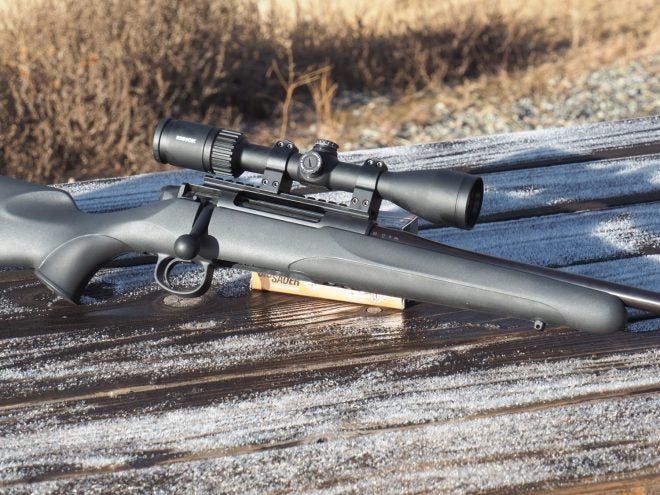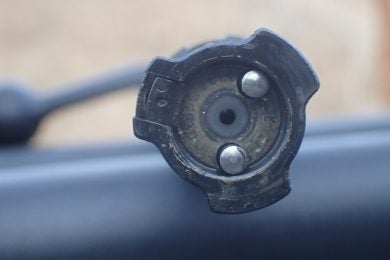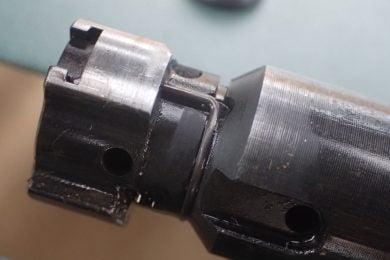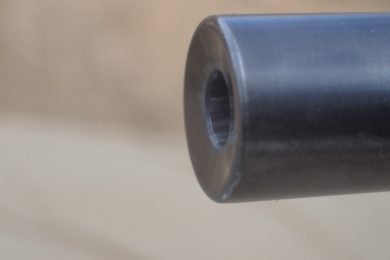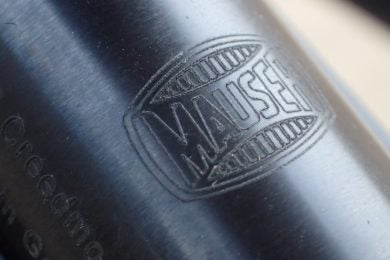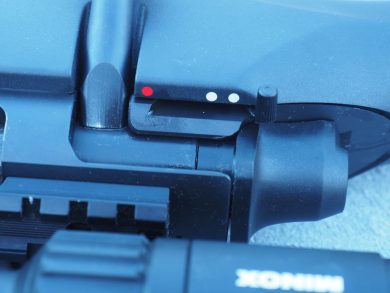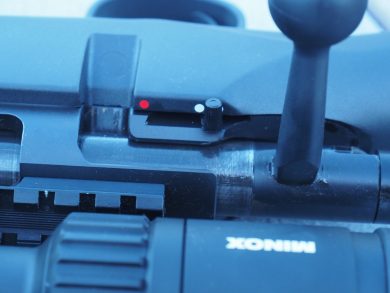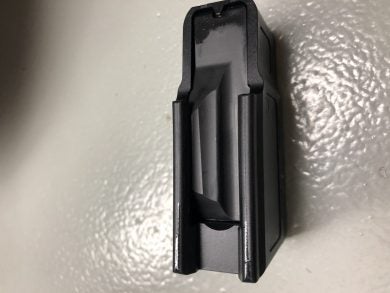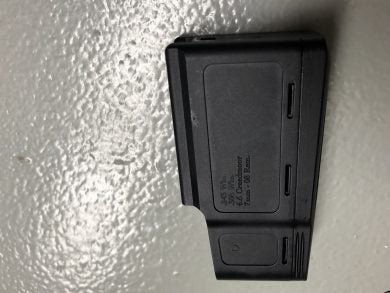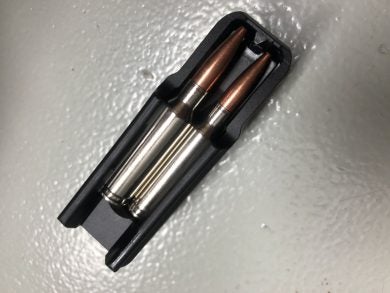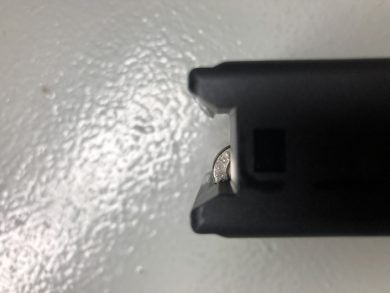The Mauser De-clawed
The most notable characteristic of a Mauser in the minds of many gun folks is the “claw”, the collared, full length extractor that has been ripping cartridge cases out of chambers since the late 1800’s. While it is a very good system with the added benefit of controlled round feeding, there are other ways of doing things. The fact is that Mauser with different types of extractors have been around since the late 60’s, with the Model 2000. The Mauser M18 uses a 3 lug Voere-style 60-degree throw bolt with dual ejectors that locks into a barrel extension up against a breech ring.
- Three lug bolt head. Note dual ejectors
- Exposed extractor spring
- Muzzle crown
The barrel itself is cold-hammer forged and then crowned. (All Mauser could tell me about the barrel steel and breech ring composition is that they are “proprietary”.) TFB’s Pete has written an excellent article on the CHF process for those interested. The M18’s stock is polymer with “soft grip inlays”. My particular test model chambered in 6.5 Creedmoor came equipped with a picatinny rail (which appeared to be the same 20 degree model that comes on the M12 Impact), and the receivers are compatible with Remington 700 long action bases. The stock and barrel finishes come in any color you want, as long as it’s black.
The Mauser M18 is billed as “The People’s Rifle” (Volksgewehr, not to be confused with the VG 1-5). It is essentially a budget-friendly version of the M12. Mauser wants this rifle to be a viable budget rifle, yet still have it retain what makes the M12 an accurate, robust hunting rifle.
Specs:
- Calibers: .243, .270, .308, .30-06, 6.5 Creedmoor, 7mm Rem. Mag, .300 Win. Mag.
- Barrel length: 22″/24″ (56/62cm)
- Weight: 6lbs, 13.4oz(3.1kg), 8lbs 8oz (3.85kg)configured with scope as tested.
- OAL: 3’5.7″/3’8″ (106/112cm)
- Capacity: 5+1
- MSRP: $699.99
Initial Impressions:
The Mauser M18 ships in a cardboard box. Inside the box is the rifle, bolt, magazine, sling swivels (studs come standard on the rifle) and a very well written and translated manual for the gun. For the purposes of this evaluation, Mauser was kind enough to send me a Minox 3-9x scope equipped with rings.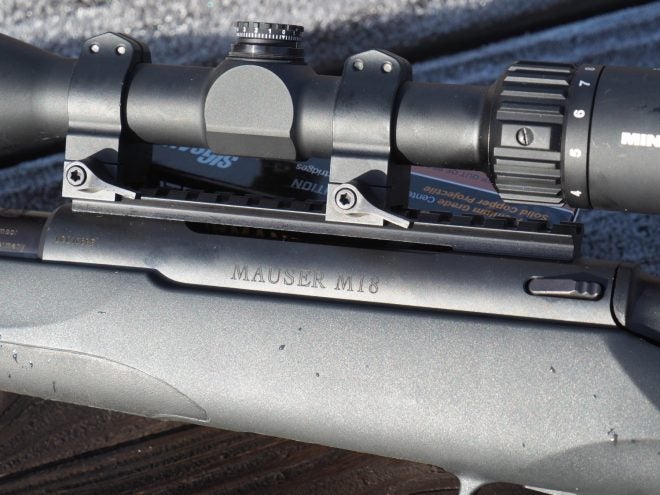
The three lug bolt had spiral machining marks along its body, and was a bit noisy at first in the receiver. After proper lubrication, this went away and it slid back and forth with hardly any noise and no wobble. The lack of wobble is due to the bolt pretty much filling the interior diameter of the receiver. The 60 degree throw was nice, but there are two definite points of resistance when working the bolt that took some practice to smoothly work through.
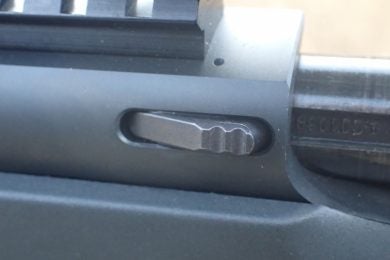
The bolt release was very easy to use
The bolt is very much a simplified M12 bolt. Instead of two sets of lugs, there is one. The safety has been moved from the rear of the bolt to the side of the receiver. Though the shroud looks significantly different, the rear of the bolt has the same large cocking indicator as the M12. The bolt release on the left side of the receiver is tactile and easy to use.
- The 3 safety positions: 2nd white dot back blocks the bolt and trigger
- Middle position allows the bolt to move but blocks trigger
- Safety fully forward in the firing position
The soft grip inserts on the stock were not squishy feeling, more like a rubberized texture to afford more grip on top of the hard polymer. The magazine release is a push button forward of the magazine well, that is nicely recessed. I was able to activate it with a gloved hand, a nice touch to have if hunting in cold weather. The stock also features a storage compartment in the butt, accessible by depressing the Mauser logo on either side of the stock.

The recessed magazine release button. Above is one of the action screws.
The trigger itself is excellent for a rifle at this price point. Adjustable from 4.2 lbs to 2.2 lbs via a hex key without disassembly, it had no creep and broke cleanly. I adjusted mine from 2.8lbs (as it came) down to 2.2 lbs for my testing purposes. The barrel is free-floated, though the stock lacks a bedding system like Ruger’s American Rifle.
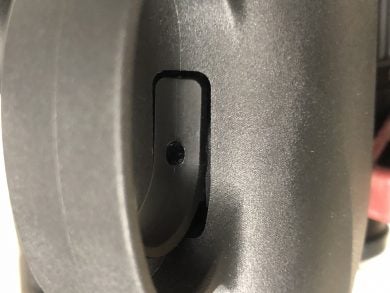
Adjustment of the trigger is done via a hex key through the trigger bow. This could be made easier by having a hole through the triggerguard itself.
At the Range
Equipped with ammunition generously provided for this test by Sig Sauer as well as my own personal; stock of 6.5 Creedmoor ammunition, I headed to the range to put some rounds on paper and steel. Intitial 5 shot groups were good enough, roughly 1.5 MOA. I then put the rifle to work hitting steel targets from 300-800 yards, with hits every time. This result confirmed to me the viability of the Mauser M18 for most reasonably ranged hunting purposes.
Moving back to the bench and using a front and rear rest, I tried to achieve the Mauser M18’s 5-shot MOA accuracy guarantee with a wide mix of ammo from Sig Sauer and Hornady to no avail. The best I could achieve with consistency was 1.16″. Perhaps I haven’t yet found the load the 1:8.66″ barrel preferred. I did expect the rifle to perform a bit better, being that .308-chambered M18’s have been able to achieve sub-MOA results. Nevertheless, it was plenty accurate for an entry-level hunting rifle.
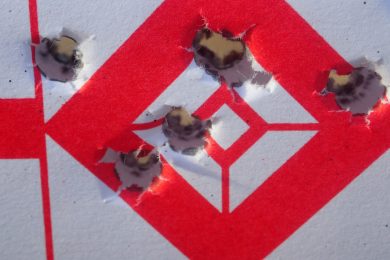
Typical group from the M18. Good, not great.
Firing over 200 rounds of 6 different loads, the Mauser M18 never failed to feed, fire, or eject. Speaking of feeding, the magazine on the M18 is simply excellent. It is a double stack polymer magazine with a rather thick body and feed lips, and functions smoothly and quietly every time. Even out of the rifle, the loaded magazine is silent with no rattle. Though it is a new design for the M18, it is also compatible with the M12. With some practice, I was able to silently chamber a round from the magazine, a nice quality to have in a hunting rifle.
- The follower allowed for smooth and quiet feeding of the rounds. It never rattled or felt loose.
- side view of magazine
- Double stack magazine.
- The magazine has very robust feed lips.
The short bolt throw coupled with the smooth feeding magazine come together to make for very fast follow-up shots. I found it easy to stay in a solid shooting position while cycling the bolt.
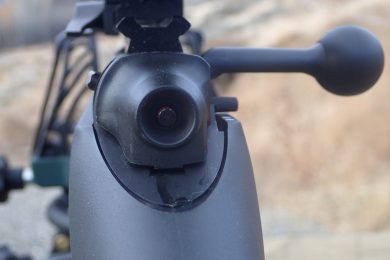
The short bolt throw provides plenty of clearance between one’s hand and the optic
In the mountains, the M18 did alright when carried on a few hunts (though I did not get to harvest anything with it). It wasn’t overly heavy or awkwardly balanced. Most importantly, it carried silently without any rattles. I did notice however that the finish was a bit lacking in robustness, scratching somewhat easily around the muzzle from sticks and branches, and at the rear of the receiver from being put down on some rocks.
Overall Impressions:
Over the years, I’ve seen and sold a lot of entry-level hunting rifles. Being that it was one of the most popular categories of firearm in my old shop, we had a lot of different ones to offer. I can confidently say that the Mauser M18 stands out as one of the best quality rifles to come in this category. If one is looking for a budget-friendly rifle, give the Mauser M18 a look. The excellent trigger and magazine, coupled with the 60 degree bolt may be the ticket you’re looking for.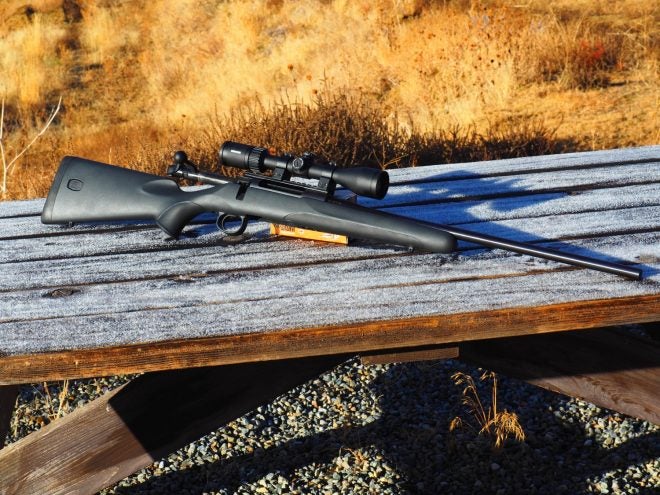
Pros:
- Excellent Magazine
- Excellent and easily adjustable trigger
- 60-degree bolt throw, handle easily clears most optics
- Capable of fast follow-up shots
- Free floated barrel
- Compatible with Remington 700 bases
Cons:
- A bit higher MSRP than US-produced rifles in the same category
- Finish wears somewhat easily
For more information, please visit Mauser.
Thanks to Sig Sauer for ammunition used in this test
Thanks to Hughston Shooting School for range time and logistical support
 Your Privacy Choices
Your Privacy Choices
